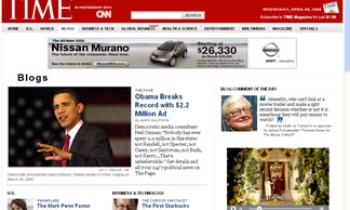Meg Scholz, a senior at the University of Texas, goes online at least a few times every day to check her e-mail.
When she does, Scholz invariably scans several news websites and blogs to see what's going on in the world. She rarely picks up a newspaper or watches TV news, because for her, the Web serves virtually all her news needs.
"It's not that I have anything against reading a printed newspaper," says Scholz, 21. "But for my lifestyle, the Internet is more accessible."
Justin Ulahannan, 22, watches TV news occasionally and he reads the print edition of The Wall Street Journal, which he gets free as an intern at the U.S. Business Council in Washington.
But otherwise, he gets news online from CNN.com or BBC.com. "It's just a matter of convenience," Ulahannan says. "Why would I pay money (for a newspaper) when I can get the same thing online for free?"
A study released today by the Pew Internet & American Life project finds that for people like Scholz and Ulahannan, the Internet has become the primary news source on the average day.
"For many of these young broadband users, the Internet is their main course for news, and they don't always eat their vegetables or order dessert in the form of using other media," says study author John Horrigan.
Though this may not come as news to anyone under 35, the results have profound ramifications for mainstream media outlets, which need to integrate an online presence as quickly as possible or risk alienating the next generation of news consumers, Horrigan says.
"Mainstream media need to search for the right business model that integrates the online experience into what they do," Horrigan says. "We're seeing the beginnings of a significant segment of the population having their daily newsgathering habits formed by what they see on the Internet."
This compares with just five years ago, he says, when Pew researchers found that high-speed users "were using the Internet to fill in their newsgathering habits. Now, it governs where they go and what they do" to get news.
The report is based on a survey in December 2005 of 3,011 adult Americans, 1,931 of whom are Internet users and 1,014 of whom have high-speed connections at home.
Within a "high-powered" group of Internet users – those who use broadband four or more times a day – 71% go online for news on an average day, while 59% get news from local TV, just over half from national TV and radio, and about 40% from local newspapers.
But especially for the under-36 age group, the local newspaper, local television and national TV newscasts play lesser roles in their newsgathering, the study finds.
The study paints a bleak outlook for traditional ink-on-paper newspapers. But it also finds that younger readers – those under 36 who are often written off as not interested in news – are being drawn into the news habit earlier thanks to the appeal of the Internet.
"To maintain relevance in a community, a local print paper has to have a very robust online presence," Horrigan says. And if local newspapers quickly merge online technology into their print operations, they stand to draw younger, Internet-dependent readers "who find traditional media less relevant for them" but are drawn to local news websites.
"If my mother can set up her own broadband connection – and she did – then it has become a technology that is reasonably user-friendly to everybody," Horrigan says. "As more and more people go to the Internet just to pass the time, just for fun, it becomes a destination, just like turning on the TV traditionally has been."
Contributing: E-mail pjohnson@usatoday.com









